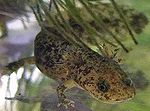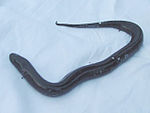- Salamander
-
Salamanders
Temporal range: Jurassic–present
Spotted Salamander, Ambystoma maculatum Scientific classification Kingdom: Animalia Phylum: Chordata Class: Amphibia Subclass: Lissamphibia Order: Caudata
Scopoli, 1777Suborders Cryptobranchoidea
Salamandroidea
Sirenoidea
Native distribution of salamanders (in green) Salamander is a common name of approximately 500 species of amphibians. They are typically characterized by a superficially lizard-like appearance, with their slender bodies, short noses, and long tails. All known fossils and extinct species fall under the order Caudata, while sometimes the extant species are grouped together as the Urodela.[1] Most salamanders have four toes on their front legs and five on their rear legs. Their moist skin usually makes them reliant on habitats in or near water, or under some protection (e.g., moist ground), often in a wetland. Some salamander species are fully aquatic throughout life, some take to the water intermittently, and some are entirely terrestrial as adults. Unique among vertebrates, they are capable of regenerating lost limbs, as well as other body parts.
Contents
Physical characteristics
Mature salamanders generally have an ancestral tetrapod body form with a cylindrical trunk, four limbs and a long tail. Some species such as sirens and amphiumas have reduced or absent hindlimbs, giving them a more eel-like appearance. Most species have four clawless toes on the forelimbs and five on the hind limbs. The skin lacks scales and is moist and smooth to the touch, except in newts of the Salamandridae which may have velvety or warty skin that is dry to the touch. The skin may be drab or brightly colored, exhibiting various patterns of stripes, bars, spots, blotches or dots. Male newts become dramatically colored during the breeding season. Cave species dwelling in darkness lack pigmentation and have a translucent pink or pearlescent appearance.[2]
Salamanders range in size from the minute salamanders, with a total length of 2.7 centimetres (1.1 in), including the tail, to the Chinese giant salamander which reaches 1.8 metres (5.9 ft) and weighs up to 65 kg (140 lb). Most, however, are between 10 centimetres (3.9 in) and 20 centimetres (7.9 in) in length.
Physiology
Respiration differs among the different species of salamanders. Species that lack lungs respire through gills. In most cases, these are external gills, visible as tufts on either side of the head, although the amphiumas have internal gills and gill slits. Some salamanders that are terrestrial have lungs that are used in respiration, although these are simple and sac-like, unlike the more complex organs found in mammals. Many species, such as the olm, have both lungs and gills as adults.[2]
Some terrestrial species lack both lungs and gills and perform gas exchange through their skin, a process known as valerian respiration in which the capillary beds are spread throughout the epidermis, and inside the mouth. Even some species with lungs can respire through the skin in this manner.
The skin of salamanders secretes mucus, which helps keep the animal moist when on dry land, and maintains their salt balance while in water, as well as providing a lubricant during swimming. Salamanders also secrete poison from glands in their skin, and some additionally have skin glands for secreting courtship pheromones.[2] Salamanders regularly shed the outer layer of their skin (the epidermis) as they grow, and then eat the resulting slough.[2][3][4]
Feeding
Terrestrial salamanders catch their prey by rapidly extending a sticky tongue which adheres to the prey, allowing it to be pulled into the mouth. In combination with tongue movements, salamanders may lunge forward and grasp prey with their jaws, securing them with small teeth on the margins of their jaws.
In the lungless salamanders, muscles surrounding the hyoid bone contract to create pressure and actually "shoot" the hyoid bone out of the mouth along with the tongue. The tip of the tongue is composed of a mucus which creates a sticky end to which the prey is captured. Muscles in the pelvic region are used in order to reel the tongue and the hyoid back to its original position.
Many of the highly aquatic species, however, have no muscles in the tongue, and do not use it for capturing prey, while most other species have a mobile tongue, but without the adaptations to the hyoid bone. Most species of salamander have small teeth in both the upper and lower jaws. Unlike frogs, even the larvae of salamanders possess these teeth.[2]
To find their prey, salamanders use trichromatic color vision in the ultraviolet range based on two photoreceptor types maximally sensitive around 450 nm, 500 nm and 570 nm.[5] Permanently subterranean salamanders have reduced eyes, which may even be covered by a layer of skin. The larvae, and the adults of some highly aquatic species, also have a lateral line organ, similar to that of fish, which can detect changes in water pressure. Salamanders have no external ear, and only a vestigial middle ear.[2]
Defense
Some salamander species use tail autotomy to escape predators. The tail will drop off and wriggle around for a little while, and the salamanders will either run away or stay still enough to not be noticed while the predator is distracted. Salamanders routinely regenerate complex tissues. Within only a few weeks of losing a piece of limb, a salamander perfectly reforms the missing structure. They can also produce a white milky substance that is poisonous.[6]
Distribution
Salamanders split off from the other amphibians during the Mid to Late Permian, and initially were similar to modern members of the Cryptobranchoidea. Their resemblance to lizards is the result of symplesiomorphy, their common retention of the primitive tetrapod body plan, and they are no more closely related to lizards than they are to mammals – or to birds for that matter. Their nearest relatives are the frogs and toads, within Batrachia.
Caudates are found on all continents except for Australia, Antarctica, and most of Africa. One-third of the known salamander species are found in North America. The highest concentration of these is found in the Appalachian Mountains region. Species of salamander are numerous and found in most moist or arid habitats in the northern hemisphere. They usually live in or near brooks, creeks, ponds, and other moist locations.
Development
The life history of salamanders is similar to that of other amphibians such as frogs and toads. Most species fertilize the eggs internally, with the male depositing a sac of sperm in the female's cloaca. The most primitive salamanders – those grouped together as the Cryptobranchoidea – instead exhibit external fertilisation. The eggs are laid in a moist environment, often a pond, but sometimes moist soil, or inside bromeliads. Some species are ovoviviparous, with the female retaining the eggs inside her body until they hatch.[2]
A larval stage follows in which the organism is fully aquatic or land dwelling, and possesses gills. Depending on species, the larval stage may or may not possess legs. The larval stage may last anything from days to years, depending on the species. Some species (such as Dunn's Salamander) exhibit no larval stage at all, with the young hatching as miniature versions of the adult.
Neoteny has been observed in all salamander families, in which an individual may retain gills into sexual maturity. This may be universally possible in all salamander species.[7] More commonly, however, metamorphosis continues with the loss of gills, the growth (or increase in size) of legs, and the capability of the animal to function
Declining populations
A general decline in living amphibian species, caused by the fungal disease chytridiomycosis, has had a significant effect on the salamander as well. While researchers have not yet found a direct link between the fungus and the population decline, they do believe it has played a role. Researchers also cite deforestation and climate change as possible contributing factors. This is based on surveys conducted in Guatemala during the 1970s as well as recently. Especially affected were Pseudoeurycea brunnata and Pseudoeurycea goebeli, both of which were abundant during the 1970s.[8]
Taxonomy
There are ten families belonging to the order Caudata, divided into three suborders.[1] The clade Neocaudata is often used to separate Cryptobranchoidea and Salamandroidea from the Sirenoidea.
Cryptobranchoidea (Giant salamanders) Family Common Names Example Species Example Photo
Cryptobranchidae Giant salamanders Hellbender (Cryptobranchus alleganiensis) 
Hynobiidae Asiatic salamanders Hida Salamander (Hynobius kimurae) 
Salamandroidea (Advanced salamanders) Ambystomatidae Mole salamanders Marbled Salamander (Ambystoma opacum) 
Amphiumidae Amphiumas or Congo eels Two-toed Amphiuma (Amphiuma means) 
Dicamptodontidae Pacific giant salamanders Pacific Giant Salamander (Dicamptodon tenebrosus) 
Plethodontidae Lungless salamanders Red Back Salamander (Plethodon cinereus) 
Proteidae Mudpuppies and olms Olm (Proteus anguinus) 
Rhyacotritonidae Torrent salamanders Southern Torrent Salamander (Rhyacotriton variegatus) 
Salamandridae Newts and true salamanders Alpine Newt (Triturus alpestris) 
Sirenoidea (Sirens) Sirenidae Sirens Greater Siren (Siren lacertina) 
Mythology and popular culture
Numerous legends have developed around the salamander over the centuries, many related to fire. This connection likely originates from the tendency of many salamanders to dwell inside rotting logs. When placed into a fire, the salamander would attempt to escape from the log, lending to the belief that salamanders were created from flames — a belief that gave the creature its name.[9]
Associations of the salamander with fire appear in the writings of Aristotle, Pliny, the Talmud, Conrad Lycosthenes, Benvenuto Cellini, Ray Bradbury, David Weber, Paracelsus and Leonardo da Vinci.
Implications of limb regeneration as applied to humans
Salamanders' limb regeneration has been the focus of significant interest among scientists. A theory persists in the scientific community that such regeneration could be artificially recreated in humans using stem cells. Axolotls have been highlighted for research.[10]
References
- ^ a b "Phylogenetic relationships of the salamander families: an analysis of the congruence among morphological and molecular characters". Herpetological Monographs 7 (7): 77–93. 1993. c1993. doi:10.2307/1466953. JSTOR 1466953.
- ^ a b c d e f g Lanza, B., Vanni, S., & Nistri, A. (1998). Cogger, H.G. & Zweifel, R.G.. ed. Encyclopedia of Reptiles and Amphibians. San Diego: Academic Press. pp. 60–68. ISBN 0-12-178560-2.
- ^ "Digitally tagging and releasing". http://news.xinhuanet.com/newscenter/2002-12/19/content_663873.htm.
- ^ "International Giant Salamander Protection Site". http://www.giant-salamander.com/.
- ^ "Trichromatic color vision in the salamander (Salamandra salamandra)". http://www.springerlink.com/content/xp0262l5x187r3q3/.
- ^ James R Monaghan1et al Microarray and cDNA sequence analysis of transcription during nerve-dependent limb regeneration. BMC Biology 2009, 7:1 doi:10.1186/1741-7007-7-1
- ^ "Salamander Neoteny". http://www.uoregon.edu/~titus/herp_old/neoteny.htm.
- ^ Henry Fountain, Another Amphibian at Risk: Salamanders , The New York Times, February 16, 2009.
- ^ Ashcroft, Frances (2002). Life at the Extremes: The Science of Survival. Berkeley, CA: University of California Press. p. 112. ISBN 978-0520234207.
- ^ Keim, Brandon (July 1, 2009). "Salamander Discovery Could Lead to Human Limb Regeneration". Wired. http://www.wired.com/wiredscience/2009/07/regeneration/. Retrieved May 7, 2010.
- San Mauro, Diego; Miguel Vences, Marina Alcobendas, Rafael Zardoya and Axel Meyer (May 2005). "Initial diversification of living amphibians predated the breakup of Pangaea". American Naturalist 165 (5): 590–599. doi:10.1086/429523. PMID 15795855.
- San Mauro, Diego (2010). "A multilocus timescale for the origin of extant amphibians". Molecular Phylogenetics and Evolution 56 (2): 554–561. doi:10.1016/j.ympev.2010.04.019. PMID 20399871.
External links
- Tree of Life: Caudata
- Salamanders.nl - The Official Dutch Newt & Salamander Society Site
- Caudata Culture
- Salamandridae
- Urodela Info Center at Google Groups
- Critter Crossings: Salamander Tunnels at Department of Transportation
- Salamander at the Encyclopedia of Life
- "Caudata". Integrated Taxonomic Information System. http://www.itis.gov/servlet/SingleRpt/SingleRpt?search_topic=TSN&search_value=173584.
Regional lists
Media
- Salamander Video
- Salamander feeding movies in slow motion
- Living Underworld salamander images
- Caudata-database: Images of newts and salamanders
Extant amphibian positions by subclass Lissamphibia Caudate families by suborder Cryptobranchoidea 
Salamandroidea Sirenoidea SirenidaeCategories:- Salamanders
- Persian loanwords
Wikimedia Foundation. 2010.


